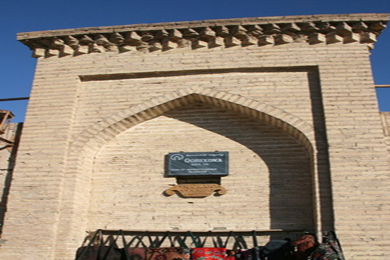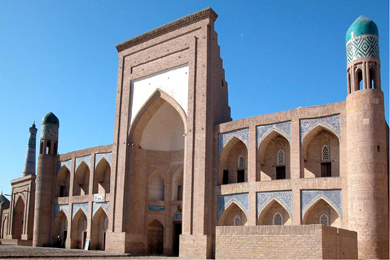Sights Of Khiva
The legend of the founding of the city tells that the city grew around the Heyvak well, from which water had an amazing taste, and the well was dug by order of Shem, the son of the biblical Noah. In Ichan-Kala (the inner city of Khiva), today you can see this well. Khiva was one of the cities of ancient Khorezm, which was a large state located in the west of Central Asia, south of the Aral Sea.
Amir Tura madrasah, Khiva Ichang-Kala among inhabited constructions is in a northern part Amir Tura madrasah. It is constructed in 1870 by the brother Mahomed Rakhim khan II (1863 - 1910) and bears his name. The high portal with an octahedral niche and a two-storied arcade of wings presents the main facade of madrasah. High walls of other external facades also create illusion of two numbers of stores.
- Details
- Category: Sights Of Khiva
- Hits: 2
Seyid Allauddin mausoleum (14th century). This known two-chamber monument of architecture, which grew into the earth, is between madrasah Mahomed-Amin khan and Matniyaz-divan-begi. The small tomb with a unique mayolikovy gravestone was constructed in the first half of the 14th century, and in the XIX century the spacious hall - a ziaretkhana with a portal entrance was added to it from the West. The gravestone in the gurkhena is executed in the Khorezm traditions of the 14th century.
- Details
- Category: Sights Of Khiva
- Hits: 2
Kunya-Ark Citadel in Khiva is located at the western gate of the city. It is the first citadel, which collapsed more than once and again built up on the old place, outside a rectangular kernel of Khiva with centuries the suburb - Rabat which in the middle of XIX in, was enclosed with fortifications too expanded. So in Khiva there were two cities: internal - Ichang-kala and external - Dishan-kala. The architecture of Khiva reached the highest blossoming in the 19th century when construction in connection with expansion and consolidation of the Khivan khanate was developed.
- Details
- Category: Sights Of Khiva
- Hits: 2
Khiva: Architectural complex Pakhlavon Mahmoud. In the national epos practically of all countries of the world mentions of people meet the remarkable force and brave heart – athletes. In Central Asia athletes are called by pakhlavons. Further, it will be a question of one of them – Pakhlavona Mahmoud.
- Details
- Category: Sights Of Khiva
- Hits: 2
At the end of the 19th century in the Pakhlavona complex of Mahmoud the mosque, madrasah and four charitable institutions – a korikhona, which served as a haven for blind people, which in Khwarezm Izz there were many strong winds with sand, were built. Here pilgrims for whom premises – hudzhra and also the dining room with kitchen – an oshkhona were provided were flown down. At the beginning of the 20th century before a tomb the two-storeyed construction was built, one of rooms of which was allocated under richly decorated Isfandiyorkhan's tomb.
- Details
- Category: Sights Of Khiva
- Hits: 2
Madrassah and Caravan Saray of Allakuli Khan (1834-1835) is opposite to Kutlug-Murad-inaka and is one of the richest on finishing. In madrasah, the city library, which pupils of all Khivan madrasahs used, was placed.
- Details
- Category: Sights Of Khiva
- Hits: 2
Tash-Hovli — a palace complex in Khiva (Uzbekistan), the main palace of the Khivan khans. The palace was located in east part of Khiva built by Allakuli-hanom. Construction of the palace took about 8 years, from 1830 to 1838.
The first built the residential quarter of a harem, then mekhmonkhon — the place for formal receptions, and the last — an arzkhona, the courtroom.
- Details
- Category: Sights Of Khiva
- Hits: 2
Palvan-Darwaza — east gate of the Khivan citadel Ichang-Kala. Were constructed in 1804 — 1806 and carried the name "Slave" as near them there took place trade in slaves in the people. Historical data demonstrate that the slave trade always prospered in this region. Especially the Turkmen tribes using at attacks of advantage of the unsurpassed racers were famous for kidnapping.
- Details
- Category: Sights Of Khiva
- Hits: 2
Kalta-Minar is a minaret located on the territory of Ichan-Kala - the inner city of ancient Khiva (Uzbekistan). Built in 1852-1855.
Kalta-Minor was intended to become the largest minaret in Central Asia if it were completed: with a base diameter of 14.2 m, its height would reach 70 m. According to the Khiva historian Munis, construction stopped in the middle due to the death of Muhammad-Amin- Khan. The minaret was called “kalta”, that is, “short”.
- Details
- Category: Sights Of Khiva
- Hits: 2
Akshi-Bobo's bastion is over an ancient citadel of the Kunya-ARC, in the city of Hiva. On a pise-walled fortification which is strengthened by semi-towers the two-story terrace – ayvan, known under the poetic name "Akshi-bobo" towers that is meant by "the aged man in love" or "Akshikh of a bean" – "the white sheikh". What formed a basis for the name of a bastion – it is unknown. The bastion from which the beautiful view of the city opens perfectly performed the functions. The enemy had no chance to approach its walls unnoticed.
- Details
- Category: Sights Of Khiva
- Hits: 2
ANUSH-HANG'S BATHS
Near Joint stock company mosque baths of Anusha-hana are located. They are constructed in 1657 and further were repeatedly under repair and reconstructed. It is considered that they were constructed in honor of Anusha-hana by his father - the governor and the famous historian Abulgazi-hanom (1644-1664) as waqf for the maintenance of this mosque.
- Details
- Category: Sights Of Khiva
- Hits: 2















